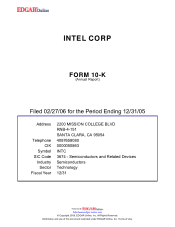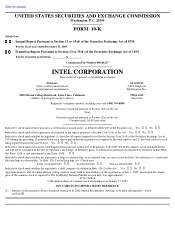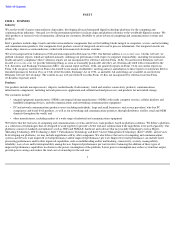Intel 2005 Annual Report Download - page 6
Download and view the complete annual report
Please find page 6 of the 2005 Intel annual report below. You can navigate through the pages in the report by either clicking on the pages listed below, or by using the keyword search tool below to find specific information within the annual report.
Table of Contents
A microprocessor is the central processing unit (CPU) of a computer system. It processes system data and controls other devices in the system, acting
as the “brains” of the computer. One indicator of a microprocessor’s performance is its clock speed, the rate at which its internal logic operates, which
is measured in units of hertz, or cycles processed per second. One megahertz (MHz) equals one million cycles processed per second, and one gigahertz
(GHz) equals one billion cycles processed per second. As computers continue to support more usage models, other factors are increasingly important
to overall platform performance. For example, microprocessors have historically contained only one processor core. Recently, we have started offering
dual-core microprocessors, such as the Intel
®
Core
TM
Duo processor and the Intel Pentium
®
D processor, which contain two processor cores and
deliver more capabilities in the form of higher system throughput and simultaneous management of activities while balancing power requirements.
Other examples of factors that are increasingly important to overall platform performance include the amount and type of memory storage, the speed
of memory access, the microarchitecture design of the CPU and the speed of communication between the CPU and the chipset. A faster bus, for
example, allows for faster data transfer into and out of the processor, enabling increased performance. A bus carries data between parts of the system.
A common way to categorize microprocessor design architectures is by the number of bits (the smallest unit of information on a machine) that the
processor can handle at one time. Microprocessors currently are designed to process 32 bits or 64 bits of information at one time. Microprocessors with
64-bit processing capability can address significantly more memory than 32-bit microprocessors. The Intel
®
Core
TM
, Intel
®
Pentium
®
, Intel
®
Celeron
®
and Intel
®
Xeon
®
branded products are based on our 32-bit architecture (IA-32), while Intel
®
Itanium
®
branded products are based on our
64-bit architecture. Another way to provide 64-bit processing capability is for processors based on 32-bit architecture to have 64-bit address
extensions. Recent product introductions from our Pentium, Celeron and Intel Xeon product families are typically equipped with Intel
®
Extended
Memory 64 Technology (Intel
®
EM64T), which provides 64-bit address extensions, supporting both 32-bit and 64-bit software applications. The
memory storage on a chip is measured in bytes (8 bits), with 1,024 bytes equaling a kilobyte (KB), 1.049 million bytes equaling a megabyte (MB) and
1.074 billion bytes equaling a gigabyte (GB). Cache is a memory that can be located directly on the microprocessor, permitting quicker access to
frequently used data and instructions. Some of our microprocessors have additional levels of cache, second-level (L2) cache and third-
level (L3) cache,
to offer higher levels of performance.
Other microprocessor capabilities can also enhance system performance or user experience by running software more efficiently. For example, we
offer microprocessors with Intel’s HT Technology, which allows each processor core to process two threads of instructions simultaneously. This
capability can provide benefits in one of two ways: it helps to run “multithreaded” software, which is designed to execute different parts of a program
simultaneously, or it helps to run multiple software programs simultaneously in a multitasking environment. Other technologies include Intel AMT,
which allows information technology managers to diagnose, fix and protect enabled systems that are plugged in and connected to a network, even if a
computer is turned off or has a failed hard drive or operating system; and Intel Virtualization Technology, which enables increased utilization of
servers and establishes a management partition that provides increased security and management capabilities. To take advantage of these technologies,
a computer system must have a microprocessor that supports the technology, a chipset and BIOS (basic input/output system) that use the technology,
and software that is optimized for the technology. Performance also will vary depending on the system hardware and software used.
Our microprocessor sales generally have followed a seasonal trend; however, there can be no assurance that this trend will continue. Historically, our
sales of microprocessors have been higher in the second half of the year than in the first half of the year. Consumer purchases of PCs have been higher
in the second half of the year, primarily due to back-to -school and holiday demand. In addition, technology purchases from businesses have tended to
be higher in the second half of the year.
The chipset operates as the PC’s “nervous system,” sending data between the microprocessor and input, display and storage devices, such as the
keyboard, mouse, monitor, hard drive, and CD or DVD drive. Chipsets perform essential logic functions, such as balancing the performance of the
system and removing bottlenecks. Chipsets also extend the graphics, audio, video and other capabilities of many systems based on our
microprocessors. Finally, chipsets control the access between the CPU and main memory. We offer chipsets compatible with a variety of industry-
accepted bus specifications, such as the Accelerated Graphics Port (AGP) specification, the Peripheral Components Interconnect (PCI) local bus
specification and the PCI Express* local bus specification. PCI Express significantly increases the data transfer rate of the original PCI specification,
thereby improving the graphics and input/output bandwidth and enabling an improved multimedia experience. Our customers also want memory
architecture alternatives, and as a result, we offer chipsets supporting Double Data Rate (DDR) and DDR2 (second-generation, faster DDR memory),
Dynamic Random Access Memory (DRAM) and Synchronous DRAM (SDRAM).
A motherboard is the principal board within a system. A motherboard has connectors for attaching devices to the bus, and typically contains the CPU,
memory and the chipset. We offer motherboard products designed for our microprocessors and chipsets, thereby providing a more complete range of
solutions for our customers looking for Intel
®
architecture-based solutions. Board-
level products give our OEM customers flexibility by enabling them
to buy at the board level rather than only at the component level.
2



















